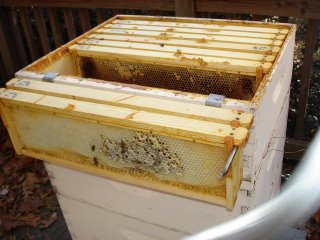Tonight the Metro Atlanta Beekeepers' meeting centered on IPM (
Integrated Pest Management). Jennifer Berry from the
University of Georgia's entomology program talked to us about studies she is involved in about the
varroa mite.
Although she did discuss some chemicals, I am not planning to use chemicals in my hive, so I won't report about that part of her talk. She did talk about research showing that the screened bottom board is essential to effective IPM. At UGA the screened bottom board stays open on the hive all winter long. She discussed three non-chemical ways to manage the varroa mite (all in conjunction with the screened bottom board):
1. Using hygenic stock such as the
Minnesota Hygienic bee or the bees raised in N Georgia by the
Purvis Brothers Apiary2. Killing drone brood. The drones are in the capped state longer than house bees and so the varroa mite likes to lay her eggs in drone cells because the mite has a greater chance to grow up. So you put drone foundation in a frame in the hive and when the cells are capped, remove the frame and put it in the freezer. This kills the drone larvae (and thus the mite can't grow). Put the dead drone frame back in the hive and the bees clean it out and start again.
3. Doing the powdered sugar shake (as I did this year). Take a flour sifter (now why didn't I think of that?) and sift the powdered sugar over the brood box. Put a sticky board under the SBB to catch the varroa which fall as the bees groom each other and the mites fall off. Then you can count the fallen mites to get an idea of how many mites are in your hive. If you do a powdered sugar shake every 10 days for a month, you should significantly lower the mite count.
I asked her about small cell bees and she said that the UGA lab is just beginning a study on small cell. One major beekeeper,
Bill Owens, in Georgia has all of his hives regressed to small cell and she talked about his successes. With 800 hives, he has only lost 3 hives this year and not to varroa.
On the other hand, she mentioned that while
Dee Lusby is going around talking a lot about small cell, she didn't feel convinced because she noted that Dee lives in Arizona and all the bees there are African honeybees - which have a shorter developmental cycle anyway and are varroa resistant. Jennifer's point was that the bees that Lusby has regressed to small cell would be small and varroa resistant because of their genetic heritage (African) and that the cell size didn't make a difference. She also talked about how long it takes to regress bees and how hard it is.
Jennifer is sampling honeycomb which Cindy Bee finds in her bee removal business. So far the "wild" comb is about 5 mm and doesn't support the theory that bees in the wild naturally build 4.9 mm comb. If you'll scroll down this
link, you'll find a short write-up about both Cindy Bee and Jennifer Berry.
In spite of all of this, I am ordering small cell foundation this winter to begin regressing in the spring.












